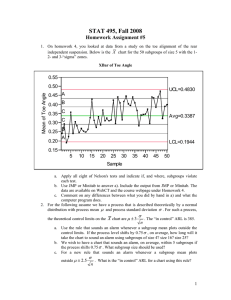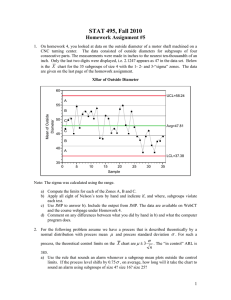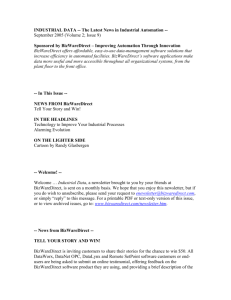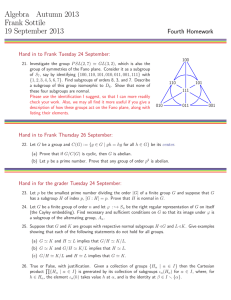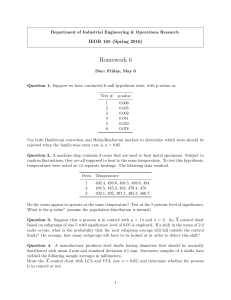STAT 495, Fall 2004 Homework Assignment #5
advertisement
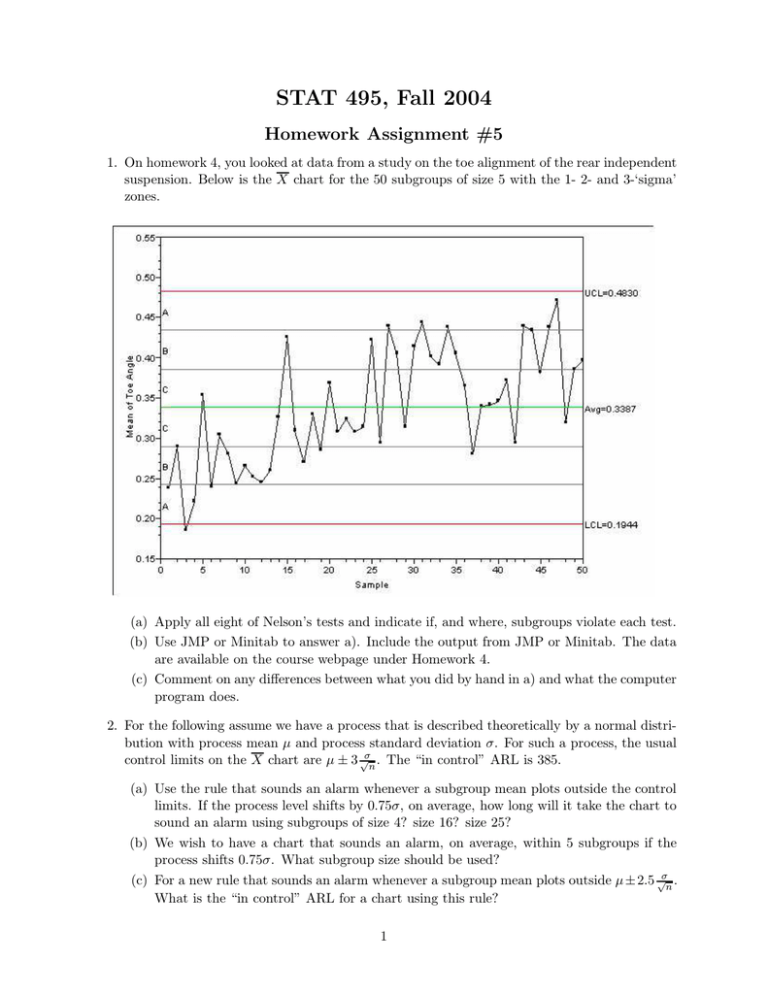
STAT 495, Fall 2004 Homework Assignment #5 1. On homework 4, you looked at data from a study on the toe alignment of the rear independent suspension. Below is the X chart for the 50 subgroups of size 5 with the 1- 2- and 3-‘sigma’ zones. (a) Apply all eight of Nelson’s tests and indicate if, and where, subgroups violate each test. (b) Use JMP or Minitab to answer a). Include the output from JMP or Minitab. The data are available on the course webpage under Homework 4. (c) Comment on any differences between what you did by hand in a) and what the computer program does. 2. For the following assume we have a process that is described theoretically by a normal distribution with process mean µ and process standard deviation σ. For such a process, the usual control limits on the X chart are µ ± 3 √σn . The “in control” ARL is 385. (a) Use the rule that sounds an alarm whenever a subgroup mean plots outside the control limits. If the process level shifts by 0.75σ, on average, how long will it take the chart to sound an alarm using subgroups of size 4? size 16? size 25? (b) We wish to have a chart that sounds an alarm, on average, within 5 subgroups if the process shifts 0.75σ. What subgroup size should be used? (c) For a new rule that sounds an alarm whenever a subgroup mean plots outside µ ± 2.5 √σn . What is the “in control” ARL for a chart using this rule? 1 (d) Use the new rule that sounds an alarm whenever a subgroup mean plots outside µ ± 2.5 √σn . If the process level shifts by 0.75σ, on average, how long will it take the chart to sound an alarm using subgroups of size 4? size 16? size 25? (e) Besides a shift in level, the process can also become more variable. Suppose we are using a chart that sounds an alarm whenever a subgroup mean plots outside µ ± 3 √σn . If the process standard deviation doubles, on average, how long will it take for an alarm to sound with subgroups of size 4? (f) What effect will changing the subgroup size to 25 have on your answer in e)? 3. A polymer product is made in a batch reaction process. The primary quality characteristic is the viscosity. Product specifications are for viscosity between 0.95 and 1.25. During the initial monitoring of the process 64 consecutive batches are made and the viscosity of each batch determined. The data are listed below and are available on the course webpage. Batch 1 2 3 4 5 6 7 8 9 10 11 12 13 14 15 16 Viscosity 1.04 1.03 1.00 1.00 0.96 0.92 1.00 1.05 1.03 1.07 1.00 0.91 0.94 1.04 1.20 1.11 Batch 17 18 19 20 21 22 23 24 25 26 27 28 29 30 31 32 Viscosity 1.17 1.17 1.28 1.17 1.35 1.06 1.03 1.25 1.14 1.09 1.13 0.86 1.07 1.09 1.22 1.11 Batch 33 34 35 36 37 38 39 40 41 42 43 44 45 46 47 48 Viscosity 1.11 1.13 1.25 1.21 1.07 1.18 1.05 1.03 0.96 1.16 1.04 0.95 0.84 1.24 1.08 1.01 Batch 49 50 51 52 53 54 55 56 57 58 59 60 61 62 63 64 Viscosity 1.01 1.14 1.07 1.14 1.14 1.10 1.01 1.01 0.94 1.04 1.03 0.88 0.92 1.09 1.24 1.10 (a) Construct Individual and Moving Range charts for the viscosity. (b) Use the average moving range to come up with an estimate of the process standard deviation. (c) Are there any points that plot outside the control limits for the moving range chart? If so, which batches are contributing to that moving range? What does this indicate about the stability of the process? (d) Are there any points that plot outside the control limits for the individuals chart? If so, which batches are sounding the alarms? What does this indicate about the stability of the process? (e) What other tests for special causes are failed on the individuals chart? Be sure to indicate the test and which batches are sounding alarms. (f) Given your answers in c), d) and e) do you think that the estimate of the process standard deviation is appropriate in b)? Explain briefly. If you feel it is not appropriate, do you suspect it is an over- or under-estimate of the process standard deviation? 2
